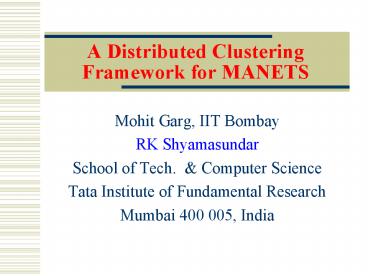A Distributed Clustering Framework for MANETS - PowerPoint PPT Presentation
1 / 24
Title:
A Distributed Clustering Framework for MANETS
Description:
A Distributed Clustering Framework for MANETS. Mohit Garg, IIT Bombay. RK Shyamasundar ... Sensor and ad-hoc wireless networks ... – PowerPoint PPT presentation
Number of Views:44
Avg rating:3.0/5.0
Title: A Distributed Clustering Framework for MANETS
1
A Distributed Clustering Framework for MANETS
- Mohit Garg, IIT Bombay
- RK Shyamasundar
- School of Tech. Computer Science
- Tata Institute of Fundamental Research
- Mumbai 400 005, India
2
MANETS
- Mobile Ad-hoc Networks no fixed infrastructure,
hosts are mobile Security, power management,
bandwidth efficiency, - Sensor and ad-hoc wireless networks
- Several challenges, for routing, data
aggregation, query processing etc.
3
Routing in MANETS
- Pro-Active Routing
- Keeping routes to all possible destinations
- Keep track of link parameters to achieve QoS
- Overhead for maintaining exchanging info.
- Reactive Routing
- Find paths on demand
- Less overhead but large delays
- Even Flooding algorithms can be clubbed under
this framework
4
Routing in MANETS Scalability
- Pro-Active Routing
- Not scalable due to the need of large bandwidth
required for exchanging network information - Reactive Routing
- Not Scalable due to large delays when source and
destinations are separated by multiple hops. - Clustering Strategies A Tradeoff
5
Clustering Algorithms
- Pro-active approaches within a cluster
- Reactive approaches for inter-cluster routing
- Provides a sort of masking with respect to
mobility of nodes - Nodes in the respective clusters update their own
links and routes when a node moves.
6
Distributed Clustering Alg.
- Use mobility to advantage (in certain
non-real-time situations they increase the
throughput) - Restrict cascading effect and achieve stability
- As MANETS have no central authority, useful to
use completely distributed strategies (emergent
algorithms)
7
Distributed Clustering Algorithm
- Clustering mechanism is independent of the
routing algorithm - It should work on a decomposed (partitioned)
network - Note that we dont maintain any cluster leader
8
Basic Leader Follower (BLF) Clustering Algorithm
- (single pass, converges faster and contains no
cluster head!) - begin initialise n,t
- w1 x
- do accept new x (loop .
- j arg (mini x-wi) (find
nearest cluster) - if x-wj lt t (if distance
less than threshold) - then wjwjn.x (join
and update the weight of the cluster) - else add new wx (form a
new cluster) - ww/w
(normalise weight) - until no more x until all points
are classified) - end
9
Towards Distributed BLF Alg
- On line algorithm (forms new clusters as and when
new data points emerge) - Several unsupervised algorithms form a basis
- Need to define
- Define a measure of closeness to capture
mobility - Adapt the algorithm as a distributed alg.
10
Distributed BLF algorithm
- Each node wakes up
- Looks around for clusters
- If finds one which satisfies a stability
threshold, keeps it as a probable candidate - Compares cluster sizes
- if suitable, joins, else forms its own cluster
11
Which one is more stable?
- Each cluster has a stability metric associated
with it which should lie above a suitably chosen
threshold for the new node to join it - Stability metric is important we have currently
chosen the cluster-age of the node
12
Cluster Maintenance
- New nodes do not join clusters if the cluster
size is equal to the maximum allowed - Minimum size also specified and clusters smaller
than that tend to disintegrate - Clusters can be dynamically maintained in exactly
the same way in which cluster formation takes
place
13
Algorithm for un-clustered Node
- while(!myself_clustered)
- transmit(clus_find)
- waitforresponses()
- parse_responses()
- choose_suitable_cluster()
- if(suitable_cluster_exists)
- send(clus_join_request)
- waitfor(clus_join_reply)
- if(clus_join_accept) updatemyclus()
- else formownclus()
- else formownclus()
14
Algorithm for Clustered Node
- while(1)
- if (size(myclus)ltMIN_CLUS_SIZE
disintegrate_time) - transmit(clus_find)
- do_work()
- if(received(clus_info)
- check_suitability()
- if(suitable_cluster_exists)
- send(clus_join_request)
- waitfor(clus_join_reply)
- if(clus_join_accept) updatemyclus()
15
Unknown Parameters in the model
- Stability Metric
- Stability Threshold
- Cluster size upper and lower limits
- Simulations shed light on how to choose the
parameters
16
Simulation Results
17
Discussion Expected Results
- Average Cluster Size should increase on
increasing MAX_CLUS_SIZE and MIN_CLUS_SIZE - Number of Clustering messages should increase
with MIN_CLUS_SIZE - Stability Metric and Threshold should govern the
lifetime of clusters
18
Scenarios
- 100 x 100 units region
- 75 nodes
- Transmission Range 15 units
- Nodes switched on at random locations in the
initial iterations - On an average half of the nodes were imparted
mobility at each instant
19
Variation w.r.t. Cluster Size Limits
- Number of clusters decrease when larger clusters
are allowed - The MIN_CLUS_SIZE does not play a very major
role. Only helps in small increase in avgerage
cluster size. - Choice of these should depend on the number of
nodes and overheads allowed
20
Variations w.r.t. Cluster Size Limits
MIN_CLUS_SIZE3, MAX_CLUS_SIZE26
MIN_CLUS_SIZE10, MAX_CLUS_SIZE26
21
Clustering Messages vs. MIN_CLUS_SIZE
MAX_CLUS_SIZE20
- Higher MIN_CLUS_SIZE means more clusters tend to
disintegrate - Hence, higher cluster overhead
22
Rate of cluster deletions vs.stability threshold
- Number of cluster deletions decrease when
stability threshold increases - But higher threshold means larger number of
clusters which may not be desirable - Gaussian metric yields lower deletions than Step
metric
23
What does the model achieve?
- Adaptive clustering
- Completely distributed algorithm
- No Cluster Head needed
- Can control cluster properties using simple
techniques?
24
Future work
- Simulation using real mobility sources
- Clustering has a wide role in MANETS Sensor
networks - finding routing algorithm taking into account
the limitations - Subdividing sensor networks into non-overlapping
sub-divisions of physically close nodes for
routing, data aggregation, query processing etc. - Location finding in the context of sensor networks































